Flags have been in use for centuries to represent countries and cultures. A flag’s main portion, which constitutes most or all of its area, is the field or ground.
Fields can feature a person, animal, natural features, or abstract designs. Each area represents something important to the country or culture.
But flags that feature people are rare and have some of the most influential people in a country. Some show the leaders of a country, others have saints on them, while others are just about the ethnic heritage of the country.
Today, we look at some of the unique flags that feature people on them. We will also dig deep into the symbolism and meaning behind these flags.
1 – The Flag of Belize
The flag of Belize is top on our list of flags that feature people. It contains a royal blue field featuring a white disc in the middle. The white disc has a coat of arms.
The flag has two red bands bordering it at the bottom and top. The People’s United Party and the United Democratic Party are the country’s national parties, and their respective colors are in use on the flag.
The original blue and white design had drawn criticism from the opposition (UDP), founded in 1973. Blue and white were the PUP’s official colors. This then led to the introduction of the red bands at the bottom and top border to represent the opposition party color.
Further, the coat of arms symbolizes the hard work put into the logging industry, which led to British settlement. This industry is also represented by tools, a mahogany tree, two men holding logging tools, and a green vine enclosing everything in the circle.

The flag of Belize consists of a blue field with the national coat of arms in the center, surrounded by two unequal red stripes.
©iStock.com/de-nue-pic
2 – The Flag of Sicily
Sicily’s flag features the Trinacria at the center and a Greek mythology Medusa—a female with living venomous snakes on her head instead of hair. The Medusa on Sicily’s flag is winged with three wheat ears.
The wheat symbolizes Sicily’s fertile land. The three curved legs (Trinacria) join to form a triangle. It is a common belief that the three legs symbolize Sicily’s three capes: Peloro, Lilibeo, and Passero.
These capes also form a triangle’s three points from the legendary Valli of Sicily. This flag is diagonally separated into two fields colored, yellow and red.
The yellow field represents the color of Corleone, while the red area symbolizes the color of Palermo. The two were the major cities behind the beginning of the ancient Sicilian Vesper Revolution. This flag was used during the revolution.

Sicily’s flag features the Trinacria at the center and a Greek mythology Medusa—a female with living venomous snakes on her head instead of hair.
©Sofia Kozlova/Shutterstock.com
3 – The Flag of Sardinia
Also referred to as the flag of the Four Moors, the flag of Sardinia has an artistic design with a rich history.
The four Moors symbolize the main ethnic communities of Sardinia and the island. Further, the Aragonese historically used it as their flag and coat of arms.
It was later used by the Savoyard Kingdom of Sardinia in 1950 and revised in 1999 into what we currently see. The flag has a St. George’s red cross on a white field with four bandaged Moors facing away from the edge of the mast. These Moors are placed on each quarter of the white area.
Previously, these Moors were not bandaged on their foreheads but blindfolded and turned towards the mast. This is according to well-preserved photos that date back to the 16th century.
The theories behind this design describe the Moors’ heads as those of Moorish princes who were defeated by the army of Aragon.
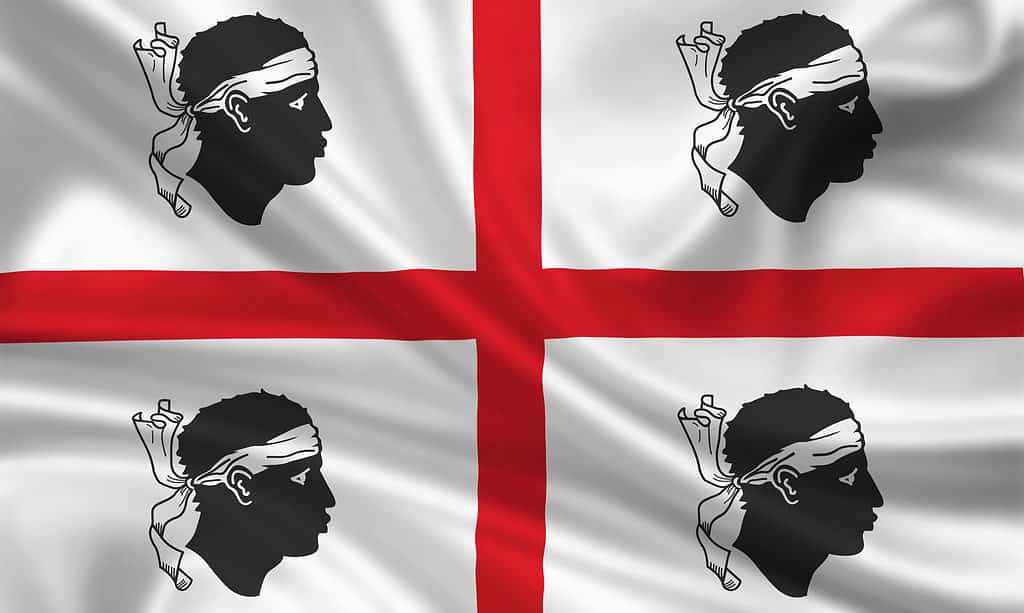
Also referred to as the flag of the Four Moors, the flag of Sardinia has an artistic design with a rich history.
©aldorado/Shutterstock.com
4 – Flag of Benin Kingdom
This particular flag has a peculiar design that stands out above the rest. The flag has an image of two men sword fighting, where one of them slays the other’s head. A red field surrounds this image.
It is said to originate from an unknown West African Kingdom. It was brought to Britain in 1897 during the Benin Expedition against the Benin Kingdom. But there are contradicting arguments on the origin of the flag.
One of the proven theories by the Royal Museums Greenwich, London, which has the flag in their National Maritime Museum’s collection. The flag was, however, removed from display in 2022. They say the flag was brought to Britain by Francis W. Kennedy, a Royal Navy officer. He has involvement in the expedition against the Kingdom of Benin in 1897.
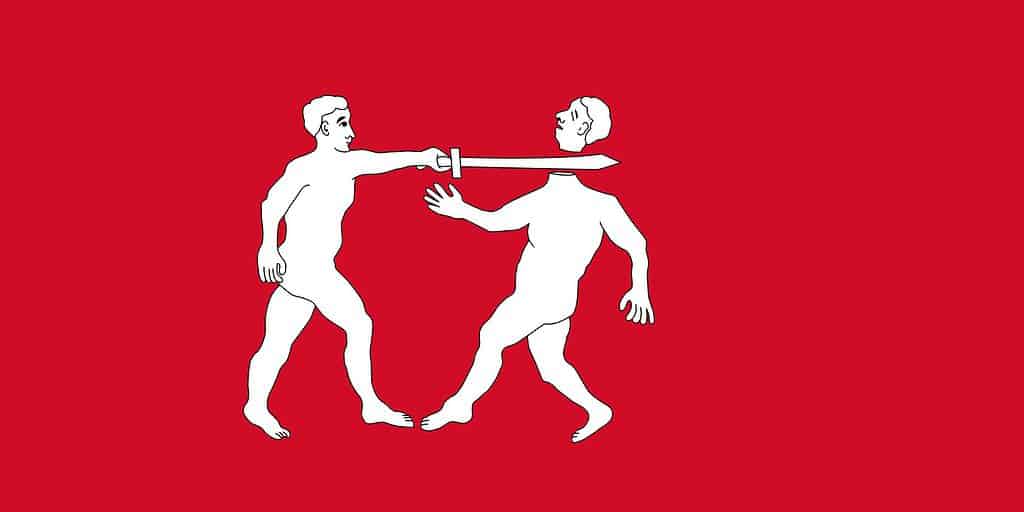
The flag has an image of two men sword fighting, where one of them slays the other’s head. A red field surrounds this image.
©SVG file, nominally 1,000 × 500 pixels, file size: 32 KB – License
5 – The Flag of Penza Oblast
The flag of Penza Oblast that featured a person was in use until April 15, 2022. It had a rectangular yellow horizontal band and a green vertical band with the “Savior Not Made by Hands (Jesus)” image at the center of the yellow field. The flag’s official height is 1:1.6, while the width is a quarter of its height. In addition, the image of Jesus measures two-thirds of the flag’s height.
This image, whose color is dark gold, symbolizes the spirituality, rebirth of the nation, and unity of the people of Penza Oblast. The green field of the vertical band represents the rich nature of the land and the vast forest that supports the flora and fauna of the region.
On the other hand, the yellow horizontal field signifies the fertile land’s wisdom, fields, and rich harvest.
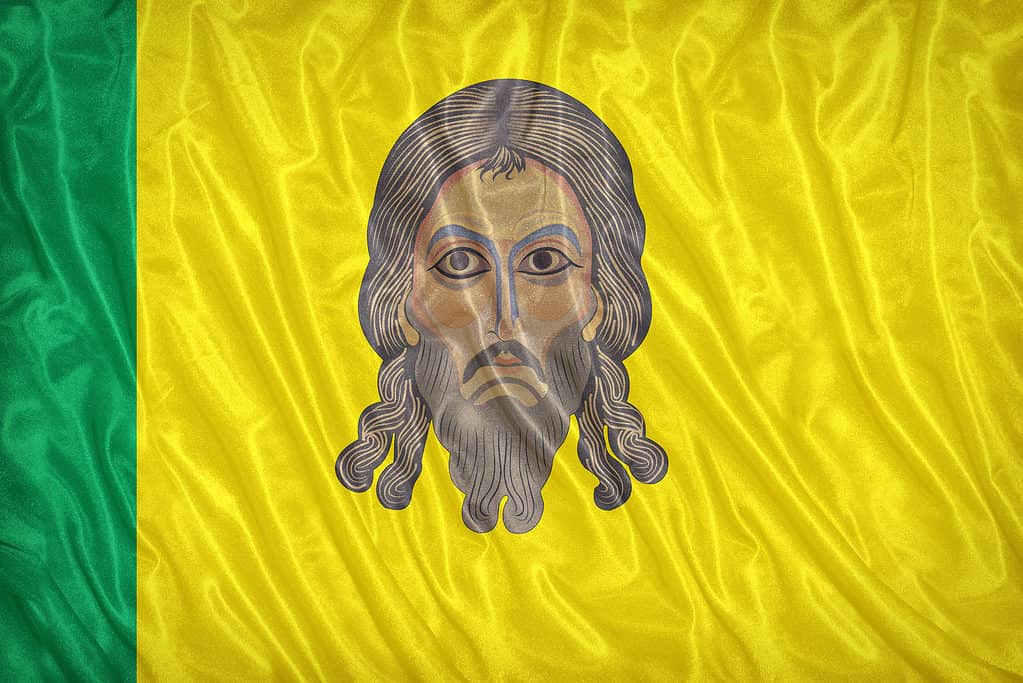
The flag of Penza Oblast that featured a person was in use until April 15, 2022. It had a rectangular yellow horizontal band and a green vertical band with the “Savior Not Made by Hands (Jesus)” image at the center of the yellow field.
©Wasan Ritthawon/Shutterstock.com
6 – The Flag of Glarus Canton
This rich Christian-dominated land is bordered by the Sernftal on the east, together with the deep valleys of the Linth River.
The conversion of the Linth Valley residents dates back to the sixth century, courtesy of the legendary Irish monk St. Fridolin. He became the only saint to be on a cantonal flag.
We see St. Fridolin in the red field of the flag of Glarus Canton, walking towards the mast as he looks in the viewer’s direction. He wears a black vestment and shoes, has a nimbus halo, white head and hands, and a yellow or gold Bible and staff.
This image has changed over the years.
At one time, St. Fridolin has a hat instead of a nimbus halo, his Bible is at times red, and his vestments are brown. From 1437 to 1578, his white staff was replaced by a bishop’s crozier. As of 1959, the saint now had pale white hands and a face as designed by Ernst Keller.

The conversion of the Linth Valley residents dates back to the sixth century, courtesy of the legendary Irish monk St. Fridolin. He became the only saint to be included on a cantonal flag.
©YueStock/Shutterstock.com
7 – The Flag of Ulster
This flag has most of its inspiration from the coat of arms of Ulster. It is used to represent the province of Ulster. The flag has a red hand designed on a white shield in the middle. The hand symbolizing the heraldry of the province of Ulster.
Further, it has a red cross situated on a golden yellow field, representing the House of Burgh.
The flag was designed in 1264 when Walter de Burgh, the first Earl of Ulster, merged the Hiberno-Norman and Anglo-Norman dynasties (House of Burgh) with the red hand of Ulster, forming the earldom that ran the Kingdom of Ulaid.
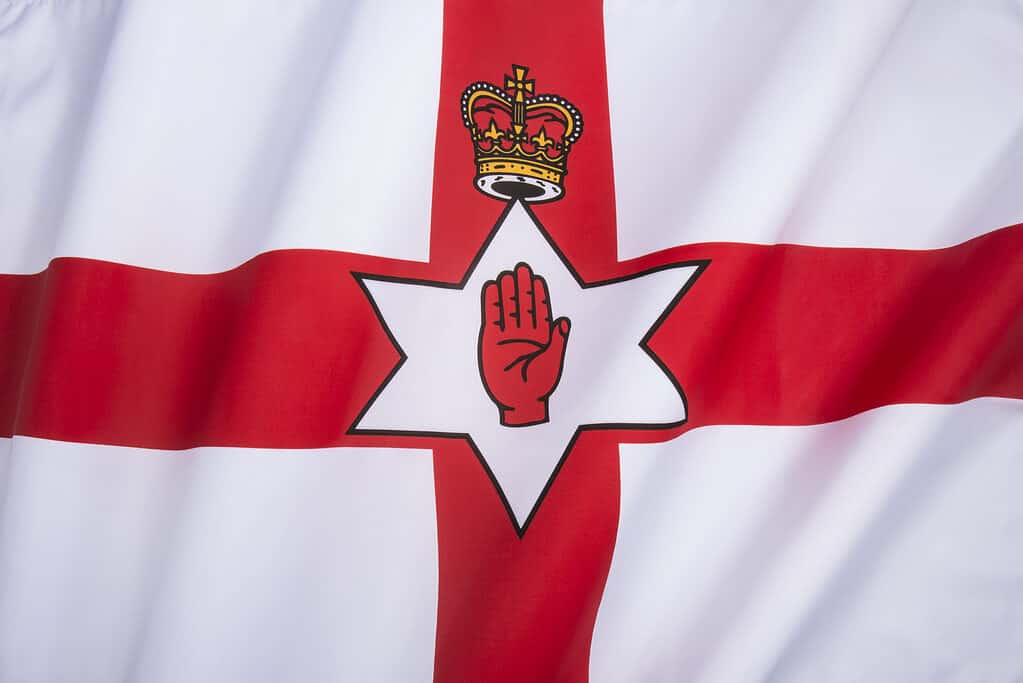
This flag has a red cross situated on a golden yellow field, representing the House of Burgh.
©Steve Allen/Shutterstock.com
8 – The Flag of Caucasus Abkhazia
The Caucasus region of Abkhazia is effectively governed by the self-declared Republic of Abkhazia, which is only partially recognized.
The Republic of Abkhazia is a South Caucasus state partially recognized by nations that consider it a part of Georgia. Further, it is as an autonomous republic per the de jure majority.
Valeriy Gamgia designed the Abkhazian Republic’s flag in 1991. The formal adoption of the flag was on July 23, 1992. The flag of the ancient Abkhazia Kingdom inspired the red canton’s design.
With the right hand extended on the flag, it said, “Greetings to friends and halt to nemesis!” Since then, a revision of the meaning of the seven stars in the flag reflects the seven ancient provinces of the nation. These are: Sadzen, Bzyp, Dal-Tsabal, Pskhuy-Aibga, Gumaa, Abzhywa, and Samurzaqan.
The Abkhaz regard the number seven as sacred. The white and green stripes stand for the peace that enables Christianity and Islam to coexist.
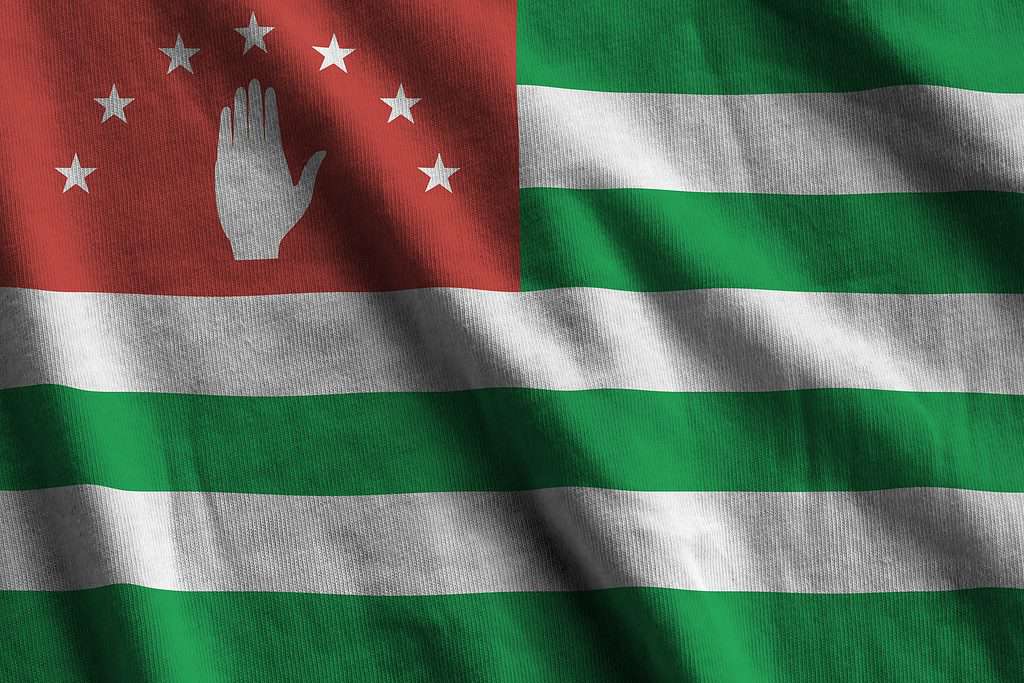
With the right hand extended on the flag, it said, “Greetings to friends and halt to nemesis!” Since then, the meaning of the seven stars in the flag has been revised to reflect the seven ancient provinces of the nation. These are: Sadzen, Bzyp, Dal-Tsabal, Pskhuy-Aibga, Gumaa, Abzhywa, and Samurzaqan.
©Mehaniq/Shutterstock.com
9 – The Flag of the State of New Jersey
In 1896, the New Jersey flag receives approval. Its official shade is buff; this is a tannish-yellow shade. During the Revolutionary war, George Washington selected the buff and dark blue (Jersey blue) of the state flag for the banner of New Jersey’s army units. The flag also displays the state seal and coat of arms.
The state’s coat of arms features a horse‘s head with a helmet underneath, three plows on a shield, which emphasize the state’s agricultural heritage, and a shield with three plows.
“Liberty and Prosperity” is the motto of the state. The two Goddesses on the left and right stand for it. On the left is freedom. Under her, the word “liberty” is visible, and she is carrying a staff with a liberty hat on it. Ceres, the agricultural goddess, is the figure on the right. “Prosperity” is below her, and she is clutching a cornucopia.
The state of New Jersey regulated the precise hues of buff and blue in legislation from 1965. As a result, buff Cable No. 65015 and Jersey Blue Cable No. 70087 are in use in the United States Cable color coding scheme. The buff and blue colors’ hexadecimal counterparts in New Jersey’s Office of the Secretary of State are #E1B584 and #2484C6, respectively.
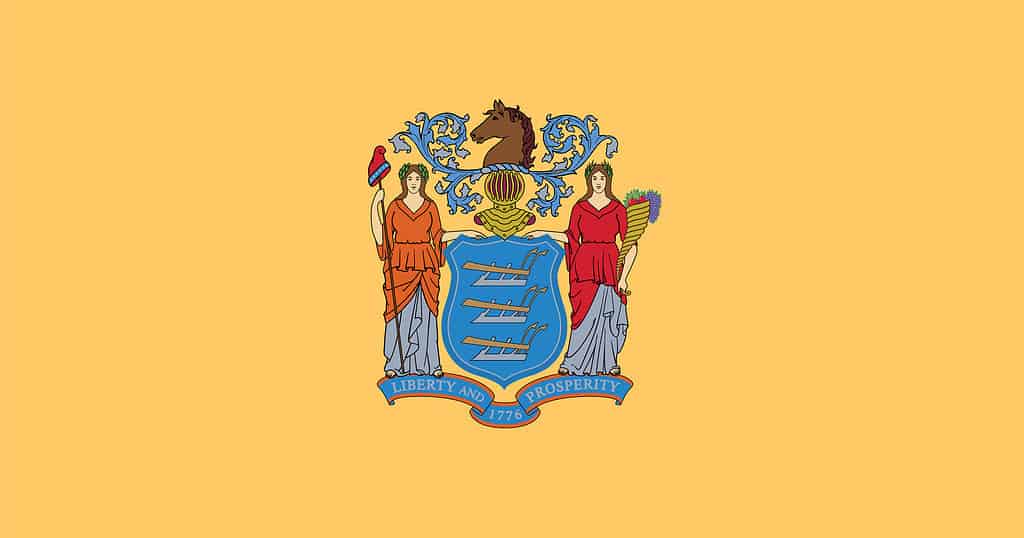
Flag of New Jersey.
©iStock.com/Kamlesh Suthar
The Flag of Washington
The state seal in the flag of Washington, featuring a picture of its protagonist George Washington, is on a dark green field with an optional gold fringe. It is the only state flag in the United States that features a green area with a picture of an American president.
In addition to certifying replica flags for retail purposes and other flag-related criteria, the secretary of state oversees flag protocol.
Since its official adoption on March 5, 1923, the flag has represented Washington. Despite becoming a state in 1889, Washington did not have a state flag. Instead, the creation of the flag is delayed to 1915 by the Washington chapter of the Daughters of the American Revolution. They later lobbied the Washington State Legislature to adopt it in the early 1920s.
Since the state flag’s inception, minor changes have occurred. One is using uniform colors in 1955 and a modified seal in 1967.
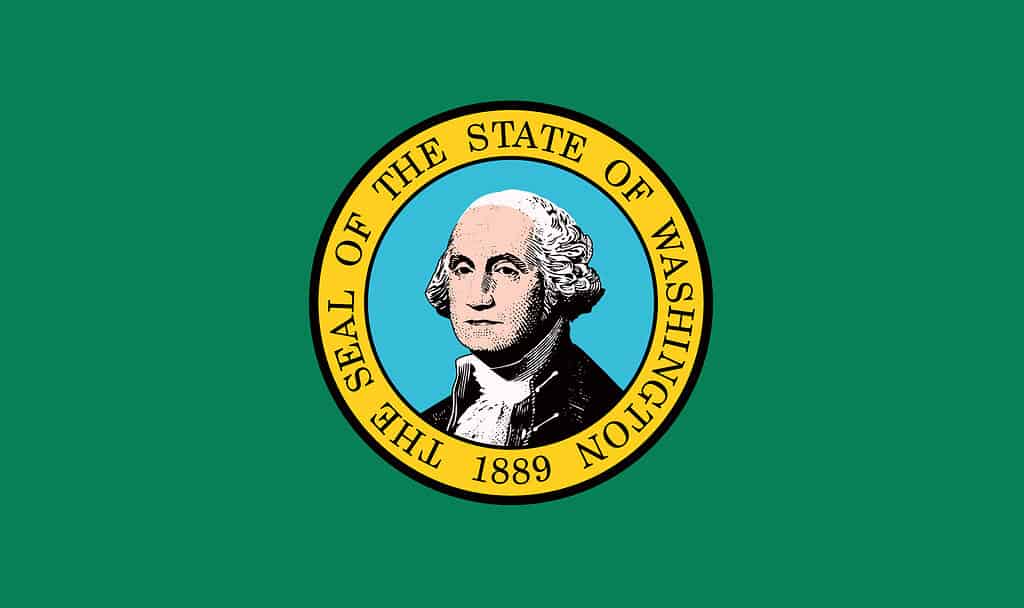
Washington USA State Flag
©iStock.com/Yurchello108
Key Takeaways
Flags have a significant role in our culture. They stand in for our nations, states, and towns. And what greater way to demonstrate patriotism than to fly a flag bearing the image of an individual or group of individuals?
Many unconventional flags depict people who stand in for a cause or community. One such flag is that of Sardinia. Four moors are on each corner of this flag. Its purpose was to symbolize the four main ethnic groups that make up Sardinia’s population.
There are plenty of other unique flags featuring people that you can find. Each with an exciting background story, as we have seen in the article.
Up Next…
- 19 Different Flags That Use Spiral Designs
- Different Examples of Flags With Diamonds
- The Different Flags That Use Crescent Shapes
The photo featured at the top of this post is © iStock.com/de-nue-pic
Sources
- Wikipedia (1970)
Thank you for reading! Have some feedback for us? Contact the AZ Animals editorial team.






